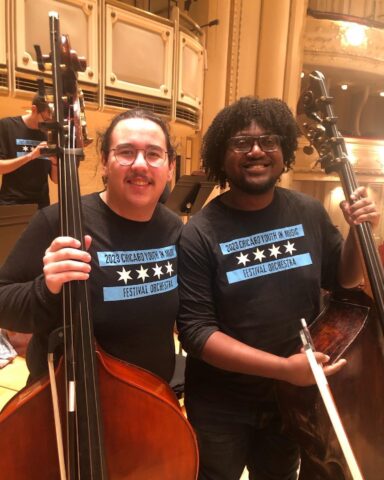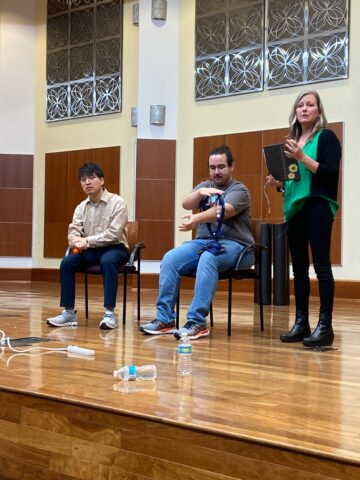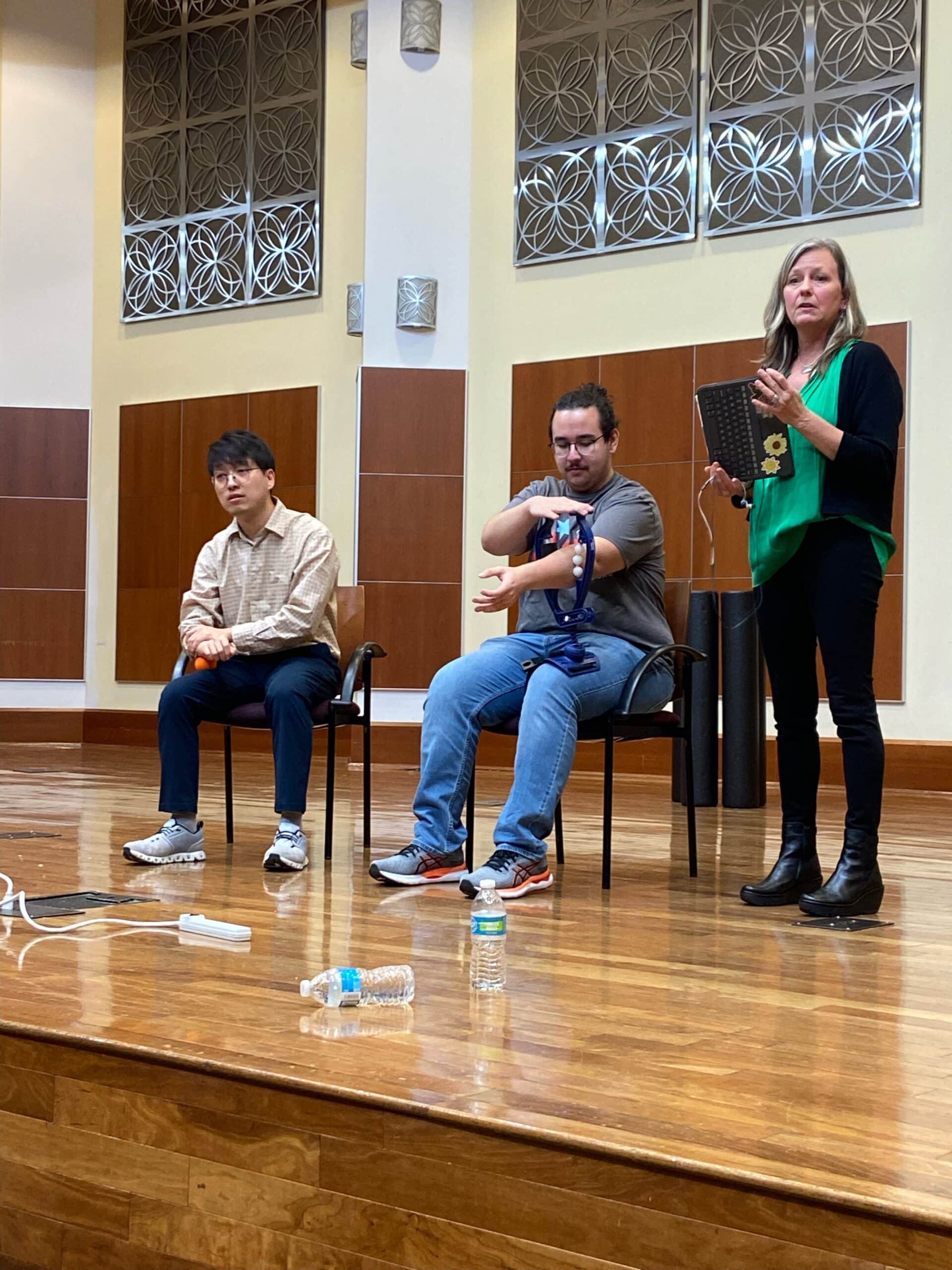CMPI Alumnus and double bassist, Mateo Estanislao, has had a rough two years of injury, rehabilitation, and rebuilding his bass playing. After being diagnosed with elbow tendinitis in January 2022, Mateo was not able to play bass for three months and did not resume private lessons until June 2022. Due to the severity of the injury and the long recovery, he planned on taking a gap year to give himself time to completely heal.
Despite expectations, Mateo recovered enough to meet and surpass his playing capabilities prior to the injury. He decided, with the advice of his private teacher, that he would audition for a smaller music program and later transfer to a more prestigious school. Mateo overlooked the stress on body, brought on by the rush of preparing audition repertoire, and strained several muscles in both his shoulders and upper back. After being cleared from occupational therapy for his elbows, Mateo started 2023 with another bout of recovery and rehabilitation that changed his entire approach to bass.
My Story
Disclaimer: Nothing I write in this article is medical advice in any way. I want to share my situation and the changes I had to make to inform and help other people.
I joined CMPI going into my junior year of high school without fully comprehending the intensity of practice that was expected of me. Many aspects of my technique were self taught at the time from what I could gather on the internet. My new teacher that CMPI introduced me to had me make a lot of changes to my setup and playing that were really new to my body. Eventually, as my practice time and intensity increased, my unfamiliarity with a different style of playing bass put a lot of strain on my muscles, ligaments, and tendons.
The expected fatigue, from increasing my playing endurance, started getting worse over winter break. It took longer and longer to recover from each practice session, but I kept pushing forward. January 2022 is when playing started to get painful. I would feel some sharp pain going through my arms after intense practice sessions. This continued to happen until my school orchestra played a holiday concert and I felt throbbing pain in my elbows. I didn’t understand the severity of the situation, so I opted to take a few days off of practicing instead of seeing a doctor.
I finally decided to get checked out after having pain during my next private lesson. My teacher and I decided to stop and talk after twenty minutes because the pain kept flaring up while I was playing. My teacher advised me to get checked out after I described everything leading up to that point. I was later diagnosed with tendinitis in both of my elbows and started therapy.
The acute pain from the tendinitis taught me to listen to my body without exception. This proved to be invaluable in my rebuild—the injury broke almost all of my muscle memory despite my mental conditioning of how I used to play bass—because it allowed me to make adjustments that catered exactly to my body.
Living with Pain
Severe injuries that require long periods of time away from playing to properly recover are the most frustrating injuries to recover from. The extended inactivity causes calluses to soften, partially or in their entirety; playing endurance, both muscular and cardiovascular, to degrade; and disconnection between the mind’s knowledge of how to play an instrument and the body’s reset of the muscle memory it accumulated from hours of practice. All of these factors inevitably lead to aggravating the injury, acute pain flare-ups, and chronic tension headaches. When memories of my previous technique and posture that caused the injury guided my body in playing bass again, pain quickly followed, as expected, and all my efforts into playing were immediately put on hold.

The chronic back and shoulder pain from muscle strain taught me that every facet of my life is intertwined without prejudice. Everything I do with music will affect my day-to-day life. This didn’t fully set in until the tension in my shoulders became painful while doing simple tasks. I could not stand up straight or walk for extended periods of time without my shoulders aching. The pain would often lead to more tension and become a vicious cycle that took me out of commission. While harsh, this was an important lesson in awareness that I completely overlooked before my injury. I started becoming more mindful of how I was moving and feeling while practicing. Then I would see the effects of it in other activities, like walking around the track in gym class. I realized that the better I took care of my body, in every aspect, the better I would feel and perform in music.
Patience, awareness, and efficiency are key in approaching a rebuild and managing all the problems brought on by the injury. It can be very easy to lose focus and not pay attention to how your body is moving, especially while under the stress of being injured. I had to essentially teach my body how to play bass again because all of the coordination I built was gone. My arms had a hard time staying in a ready position to the point where my posture completely broke down as if I was a beginner on my instrument. Whenever my posture was compromised and my elbows were in a bad position, I would be in pain almost immediately.
The aches I felt in my body that stopped me from dedicating time to my instrument became incredibly stressful. If I was not aware of the tension in my body, then my practice sessions wouldn’t be effective. I had to take time away from practicing to check in with my body and alleviate as much tension as I reasonably could before I could even think about picking up my instrument. Since my practice time was limited, I learned to be efficient in planning out what I need to accomplish at each stage of my recovery. I learned to be efficient in using my body to maximize the time I could practice before my body was in pain again. The lessons I learned from these injuries are the principles of my approach to bass and how I continue to adapt to this day.
Musicians as Athletes
Something that we don’t often realize as musicians is how we engage our entire body while playing. The idea that musicians are also athletes is crucial to the longevity of our career. One of my prior teachers, who guided me when I first started playing after the injury, emphasized this principle. Playing any instrument should never be painful in the same way that a pitcher shouldn’t be in pain while throwing a baseball. There will be some soreness from engaging different muscles than we’re used to. There will be fatigue from extended playing that pushes the limits of our endurance. But the moment those turn into pain, something has gone wrong.
SD Rehab’s CMPI Community Meeting on injuries reminded me of this lesson and brought a new perspective to the table. Injuries generally occur from overuse, inefficient technique, or some combination of both that puts the body under excessive stress that it can’t handle.
My daily practice routine starts well before I pick up my instrument by minimizing any tension, pain, or aches of any kind. This usually includes foam rolling to help relax my back and stretching out my legs, shoulders, arms, and hands. I’ve recently adopted many of the foam roller exercises and stretches from SD Rehab’s presentation. These help me directly target areas in my legs, back, upper arms, and neck that I couldn’t engage before. I also incorporated core strengthening to some degree each day.
As a bassist, my legs are actively engaged while I’m playing to keep me in a comfortable and stable position on my stool. They are literally the foundation to our posture that everything else is built upon. My core is also actively engaged while playing to prevent my back from rounding. This ensures that my posture is relatively consistent throughout a practice session and allows my shoulders to be in an optimal position at all times. If my posture is set and my shoulders are relaxed, then my arms can comfortably engage with my instrument in most positions.

This idea of building my posture from the ground up has led me to be more comfortable with my instrument. It extends the length of time I can play, and it allows me to produce a better sound from my instrument. Engaging several muscle groups while playing can be uncomfortable, especially if it’s new to you, and lead to soreness. That is why I stress the importance of taking care of your entire body, not just the specific muscles that are used to play.
The Importance of Setup
My setup is something that has changed several times in the past two years to suit my needs. There are typically two goals with a double bass setup, maximizing your performance capabilities and comfort by adjusting the height of your stool and bass. This is still an ongoing challenge in my pursuit of being as comfortable as possible while being able to perform at the highest level I can. My current teacher is my source of inspiration in this regard. He is able to play in all positions on the bass with little change in his posture. He is one of the most relaxed bass players I’ve seen and he is able to make a beautiful sound in any register.
To that goal, my setup is a part of my body while playing because it is what enables the execution of my musical ideas. It becomes a physical extension of my music to the same extent of my instrument.
My setup has changed in conjunction with my recovery. When I first started playing after my injury, my goal was to maximize my comfort so I could establish my technique. I used to have a really low stool and bass to accomplish this. Now that I am recovered, I have a much higher setup that is more demanding on my legs and core, but it sets up my arms to be relaxed and helps me produce a better sound. No matter what instrument you play, finding a setup that works with your body will lead to more productive playing and longevity in your career.
Practice Efficiency
Being efficient in my practice time has been the biggest factor in improving as a musician since getting injured. The initial time constraints due to pain and endurance led me to focusing on very specific goals in my practice. Some of my first practice sessions consisted of me sitting with my bass and thinking about how every part of my body engages in my instrument. I didn’t play anything other than open strings to feel the resistance of the string against the bow and how that affected my back, shoulders, and arms. This fine attention to detail is how I recovered and rebuilt my technique to be efficient with my body.
Sometimes efficiency in practice means knowing when to stop. Your body will tell you when it’s necessary through fatigue and pain, if you go far enough past your limitations. Whether you stop playing and rest for five minutes to collect your thoughts, you put your instrument down to stretch because you started tensing up, or you do something else entirely because you can’t focus and need a distraction to regroup, all of these contribute to your improvement as a musician and person.
I make sure to take rest days, when I don’t touch my instrument at all, once a week to give myself time to recover and focus on mental practice. Deciding not to practice for a day or more is not necessarily a bad thing. It can be used as a preventative measure for both your mental and physical wellbeing. They’re also necessary if you have occasional injury flare ups to ensure that your condition does not regress. After my college auditions, concert days, and musical performances I always took at least two days off to allow my mind and body to recover. I’ve also had a few situations that required anywhere from three days to a whole week off. Those are things like a stressful deadline that requires significantly more practice to prepare for or a festival that has rehearsals all day long.
Regardless of the duration of rest, staying mentally engaged with music is essential. Whether it’s listening to your large ensemble pieces with a full score, planning out what you want to accomplish in the following days of practice, or simply enjoying music, all of these are productive forms of mental practice. If the idea of not improving during a rest day stops you from taking one, then make sure you accomplish something and give a purpose to your time off. You hold the power to create the best outcome of any situation. Creating a greater purpose to rest days will make all the difference.
Knowing when you can be productive while practicing and when you need to take a break differentiates how good musicians and great musicians approach practice. A good musician will keep practicing until they reach their limits. A great musician will be aware of their body at all times, be patient with their limitations, and be efficient in the way they structure their practice and utilize their technique. This isn’t said to be negative in any regard. Practicing to your limits isn’t necessarily bad. However, in my experiences with injuries that could end my career in music, this approach to practicing has been pivotal in my growth as a musician.
Due to the risk of aggravating my arms and shoulders, I typically take longer breaks in between practicing. I always give myself enough time for my body to relax and distract my mind with the goal of being as productive as possible when I return. If I take a long enough break and my muscles are no longer warm, then I make sure to get up and move before practicing. This usually consists of walking around the house for a few minutes, a slow left hand warm up, and open strings.
While this has served me well, I recently had a tendonitis flare up in my left elbow. After a rehearsal break, the orchestra worked on a very technical section of music that caused my tricep, forearm, and hand to tense up and hurt. The repetition of this section caused my left arm to stiffen to the point that I had trouble bending my wrist and moving my fingers.
Techniques from Physical and Occupational Therapists
I brought this issue to Thomas and Stephanie from SD Rehab after their CMPI presentation and got some new ideas to help manage flare ups and prevent them in the future. Thomas suggested massaging any problem areas that could tense up to stimulate blood flow. This has been especially helpful for rehearsal breaks to release built up tension, prevent my arms from freezing up, and to prepare my body for the rest of rehearsal. In my own practice, this has been helpful in making sure my arms are ready after a longer break and extending how long I can practice in one sitting.

Stephanie suggested experimenting with KT Tape to serve the same purpose, stimulating blood flow, without manually massaging the area. While I haven’t tried this yet, the idea is very appealing and the logic seems sound. It seems like it’d be especially effective in rehearsals during long rests in the music, because your focus needs to be with the orchestra; cold weather, because the temperature will tighten up the muscles; and concerts, because a massage will be less effective with a suit on. As the winter season of holiday concerts and college prescreens comes upon us, KT Tape will definitely be an important resource for me.
Learning from Injury
While it is a terrible experience to deal with an injury, it is something I’d never wish for someone else to go through, I think there is an inherent wisdom that comes from the experience. There are opportunities for growth that are very difficult to understand without that experience. I severely underestimated the possibility and effects of injury when I started taking music seriously. I would practice scales, arpeggios, and technique for hours on end. Then I would work on solo repertoire, youth orchestra music, and anything else I was interested in. Then I got injured with bilateral elbow tendonitis and my music career was at risk of ending before it could really begin.
I intellectually understood the risk and consequences of injury, but the emotional and mental stress of my situation changed me. My hope in sharing my experience with injury, recovery, and the steps I’ve taken to build longevity is to show the significance of injury without having to experience it. The concepts of patience, awareness, and efficiency are the most important lessons I’ve learned from being injured. They’ve changed my life and I hope they can change yours too.
Images
Mateo at CMPI Community Meeting with SD Rehab, Mateo at Youth in Music Festival, and Mateo at National Pathways Festival
